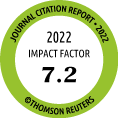Return to content in this issue
Airway Reactance Predicts Static Lung Hyperinflation in Severe Asthma
Li YJ1, Ko HK2,3, Pan SW2,4, Feng JY2,4, Su KC2,5, Li Y1, Yang SN6, Hsiao YH2,7,*, Perng DW2,7,*
1Department of Chest Medicine, Taipei Veterans General Hospital, Taipei, Taiwan
2School of Medicine, College of Medicine, National Yang Ming Chiao Tung University, Taipei, Taiwan
3Division of Respiratory Therapy, Department of Chest Medicine, Taipei Veterans General Hospital, Taipei, Taiwan
4Division of Pulmonary Immunology & Infectious Diseases, Department of Chest Medicine, Taipei Veterans General Hospital, Taipei, Taiwan
5Division of Clinical Respiratory Physiology, Department of Chest Medicine, Taipei Veterans General Hospital, Taipei, Taiwan
6Department of Pharmacy, Taipei Veterans General Hospital, Taipei, Taiwan
7Division of General Chest Medicine, Department of Chest Medicine, Taipei Veterans General Hospital, Taipei, Taiwan
*These authors contributed equally to this work.
J Investig Allergol Clin Immunol 2024; Vol 34(2)
: 106-117
doi: 10.18176/jiaci.0888
Background: Static lung hyperinflation (SLH) measured using body plethysmography in patients with asthma is associated with poor outcomes. The severity of SLH may be associated with small airway dysfunction (SAD), which can be measured using impulse oscillometry (IOS).
Objective: This study aims to determine the correlation between SLH and SAD in patients with severe asthma and assess the improvement in SLH and SAD with treatment.
Methods: We analyzed data from patients who were enrolled in the Taiwan Severe Asthma Registry, which comprises a prospective observational cohort. Plethysmography and IOS were performed regularly. The relationship between spirometry and IOS parameters was determined. Changes in the clinical outcomes in response to treatment were analyzed.
Results: Of 107 patients with severe asthma, 83 (77.6%) had SLH based on an increased residual volume to total lung capacity ratio (RV/ TLC). Most patients were older women with worse pulmonary function and SAD than those without SLH. SAD, defined as increased airway resistance/reactance, was significantly correlated with SLH. Airway reactance at 5 Hz (X5) ≤−0.21 kPa/(L/s) detected SLH with an area under the receiver operating characteristic curve of 0.84 (P<.0001; sensitivity, 85.2%; and specificity, 83.3%). After 12 months, patients who received add-on biologics (vs those who did not) had significantly reduced exacerbations, fractional exhaled nitric oxide level, and blood eosinophil counts, as well as improved forced expiratory volume in the first second, X5, and a trend toward reduced RV/TLC ratio.
Conclusion: In severe asthma, airway reactance (X5) could be a novel parameter for assessing SLH.
Key words: Body plethysmography, Impulse oscillometry, Static lung hyperinflation, Severe asthma
| Title | Type | Size | |
|---|---|---|---|
 |
doi10.18176_jiaci.0888_supplemental-materials-tables.pdf | 269.25 Kb | |
 |
doi10.18176_jiaci.0888_supplemental-materials-figures.pdf | 411.11 Kb |



